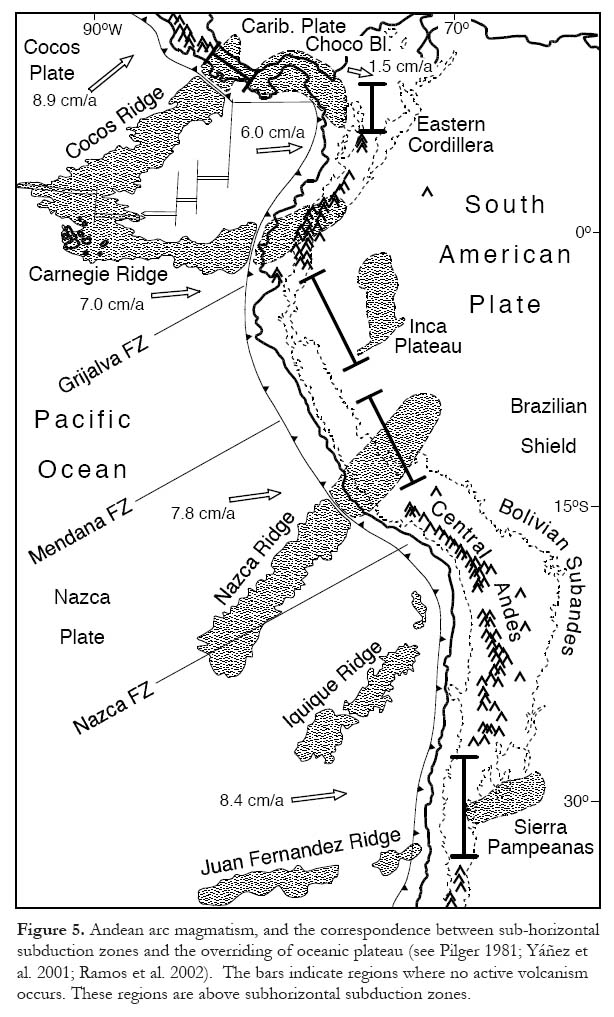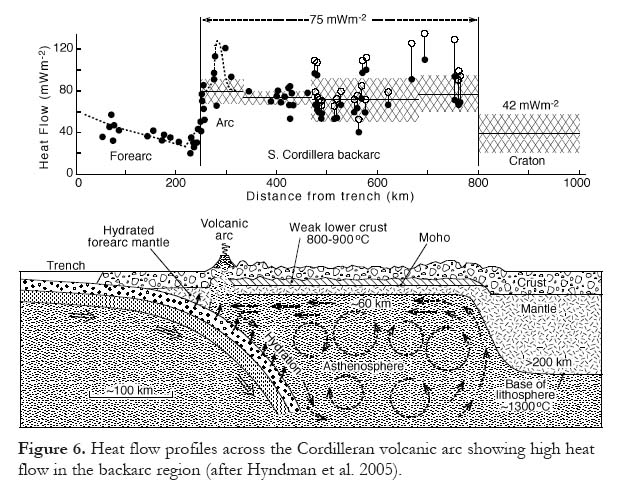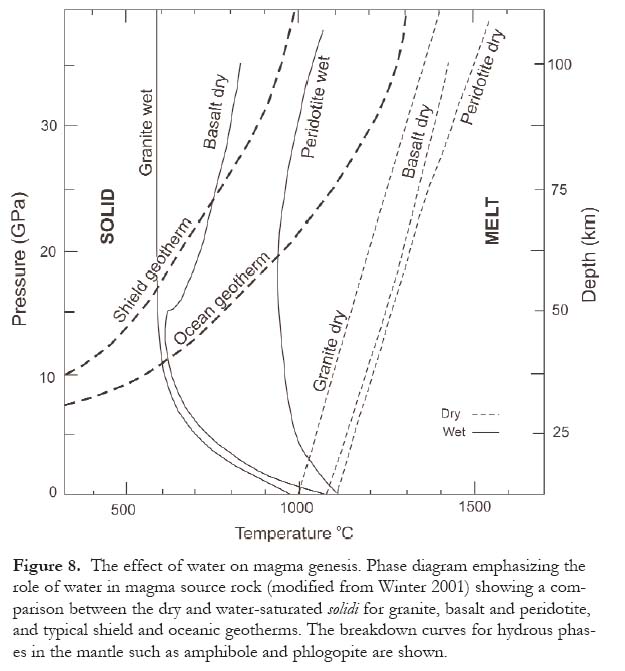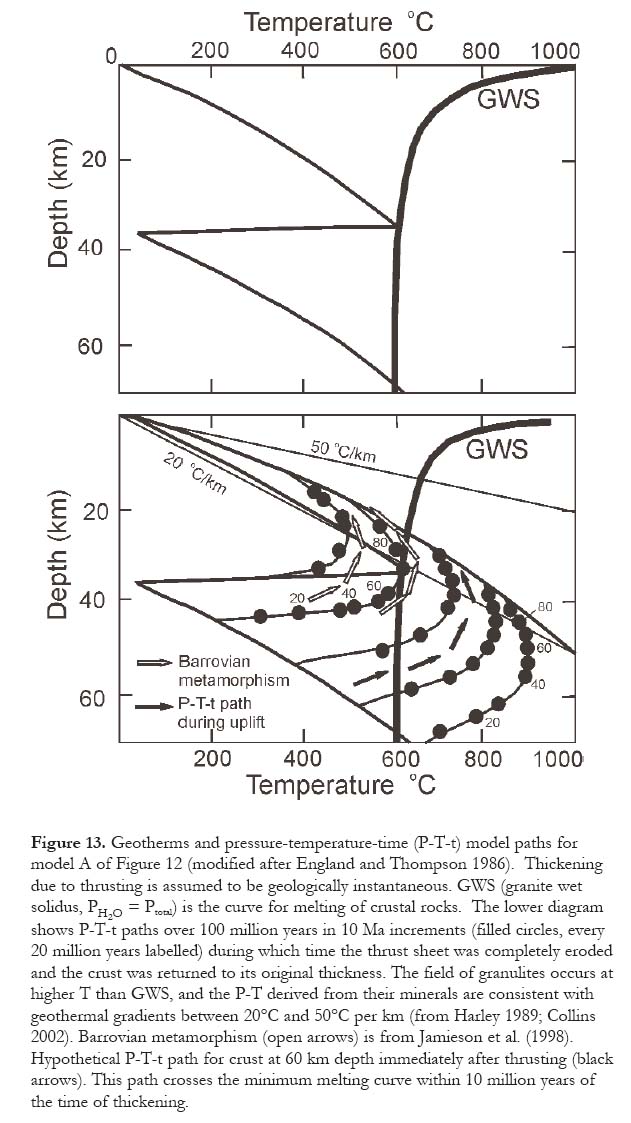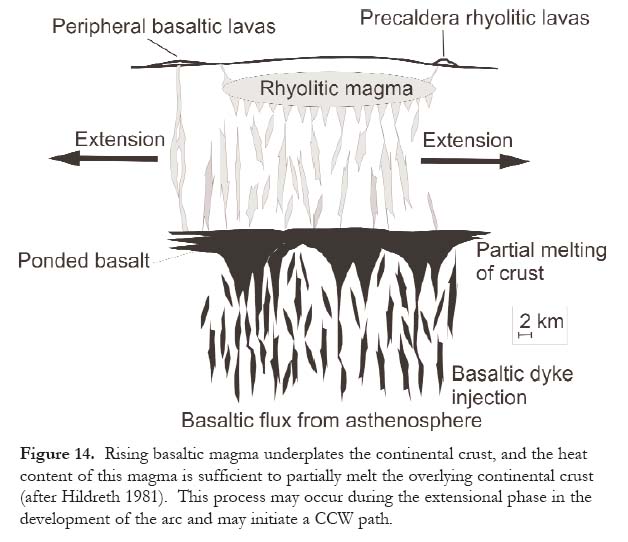Igneous Rock Associations 7.
Arc Magmatism I: Relationship Between Subduction and Magma Genesis
J. Brendan MurphyDept of Earth Sciences, St. Francis Xavier University, Antigonish, NS, Canada, B2G 2W5
bmurphy@stfx.ca
Accepted as revised, 5 January 2007.
SUMMARY
Dehydration of subducted oceanic lithosphere releases fluid into the overlying mantle wedge and initiates a chain of events culminating in the generation of magma that rises to form volcanic arcs. Arc magmas are distinct from magmas in other settings because of the different geothermal regimes at destructive plate margins, the presence of fluids/volatiles derived from dehydration of the subducted slab and the generally compressive tectonic regime that inhibits the ascent of magma, thereby promoting extensive interaction with the adjacent wall rocks. As a result, most arc magmas solidify as intrusive bodies, ranging from sills and dykes to large plutonic complexes. Several mechanisms facilitate the rise of arc magmas. Diapirs rising from a larger pool of buoyant magma are important in the ductile lower crust. The rapid rise and the expansion of magma results in the propagation of fractures, that facilitate stoping and assimilation in the brittle upper crust. Fracture zones are repeatedly exploited, and the net result may be formation of a composite batholith.Water plays an important role in all stages of arc-magma evolution. Water lowers the temperatures that are required for the partial melting in the mantle wedge, which produces mafic magma, and in the crust, produces felsic magma. Arc magmatism is intimately related to metamorphism, although this relationship is complicated largely because maximum pressures and temperatures are attained at different times. Arcs under compression undergo rapid thickening, followed by erosional or tectonic exhumation. Crustal melting is triggered by a variety of processes, including relaxation following crustal thickening. Melting initiates at the base of the crust, but eventually occurs at shallower crustal levels. Arcs under extension have a steep geo-thermal gradient and underplating of the crust by mafic magma may transfer sufficient heat to induce anatexis. During a prolonged history of subduction, the dip and location of the subduction zone may vary causing the locus of arc magmatism to migrate and causing intermittent switching from compressional to extensional environments.
SOMMAIRE
Le phénomène de déshydratation qui accompagnent la subduction de la lithosphère océanique relâche des fluides dans le prisme mantélique susjacent et initie une suite d’événements qui conduit à la génération de magmas qui forment des structures d’îles en arc. Les magmas d’îles en arc diffèrent des magmas d’autres contextes parce que les régimes géothermaux aux lieux de destruction de marges tectoniques sont différents, étant donné la présence de fluides et/ou de volatiles issus de la déshydratation de la plaque en subduction, et du régime tectonique généralement compressif qui inhibe l’ascension du magma, d’où l’importance de l’interaction avec la roche encaissante. En conséquence, la plupart des magmas d’îles en arc forment des intrusifs, variant des filons-couches, aux dykes aux complexes plutoniques. Plusieurs mécanismes favorisent l’ascension des magmas d’îles en arc. Ainsi, l’ascension de diapirs à partir d’une grande accumulation de magma moins dense que l’encaissant est-il un phénomène important dans la croûte inférieure ductile. Cette ascension rapide jointe à l’expansion du magma provoque la propagation de fractures, ce qui facilite l’agrégation et l’assimilation de l’encaissant dans la portion supérieure cassante de la croûte. Fréquemment, le magma injecte ces zones de fractures, ce qui conduit parfois à la formation d’un batholite composite.L’eau joue un rôle important à toutes les étapes de l’évolution des magmas d’îles en arc. La présence d’eau abaisse les températures de fusion partielle dans le prisme mantélique, ce qui conduit à la formation de magmas mafiques, et de magmas felsiques dans la croûte. Le magmatisme d’île en arc est intimement lié au métamorphisme, bien que cette relation soit compliquée, surtout parce que les pressions et les températures maximales sont atteintes à des moments différents. Les magmas d’îles en arc en situation de compression s’épaississent rapidement, puis sont érodés ou exhumés tectoniquement. La fusion de la croûte est déclenchée par une variété de processus, dont la détente accompagnant l’épaississement crustal. La fusion se produit d’abord à la base de la croûte, mais elle atteint éventuellement des niveaux moins profonds de la croûte. Les magmas d’île en arc en situation d’extension ont un gradient géothermal très pentu, et le placage de la croûte par un magma mafique peut y apporter assez de chaleur pour provoquer l’anatexie. Si l’histoire de la subduction se prolonge, le contexte d’un système d’îles en arc peut alterner épisodiquement d’un régime en compression à un régime en extension.
INTRODUCTION: A REVIEW OF THE TECTONICS OF DESTRUCTIVE PLATE MARGINS
1 This is the first of two articles on arc magmatism intended for geoscientists who do not specialize in petrology or geochemistry, but who are interested in the relationship between the tectonic evolution of arcs and magma petrogenesis. This article is intended to explore that relationship and to set the stage for a companion article that focuses on the geochemical, isotopic and petrological evolution of arc magmas and that will be published later by this journal. A review of the role that plate tectonics plays, including the effects of subduction on the upper plate (the trench, the fore-arc, arc and backarc), the contrasting heat-flow regimes, and the effect of changes in the profile of the subduction zone with time is first presented here. The products of arc magmatism, from the pyroclastic and lava deposits that erupt at the surface to the intrusive rocks in the plumbing system at depth, are described, as are the varying processes governing the ascent of arc magma and the controversies associated with the mechanisms of intrusion. The critical role of water, derived from dehydration of the subducted slab, is considered in all stages of arcmagma evolution, from the generation of the magma in the mantle and crust, during its rise toward the surface, to its final cooling and crystallization. This article concludes with an examination of the varying relationships between arc magmatism, metamorphism and deformation during subduction-related orogenesis.
PLATE TECTONIC SETTING
2 Plate tectonics plays a crucial role in the generation of arc magmas. On a globe of constant volume, the creation of lithosphere at constructive margins (where two plates move apart) is balanced by the destruction of lithosphere at destructive margins (where two plates collide). This balance is apparent on paleocontinental reconstructions for the past 200 million years, which show that the Atlantic Ocean expanded by seafloor spreading as the Pacific and Tethys oceans contracted by subduction (Fig. 1). Subduction eventually resulted in closure of the Tethys Ocean about 35 million years ago as the collision of Africa and India into Eurasia formed the Alpine-Himalayan mountain chain. However, subduction has persisted along most of the circum-Pacific region, where the abundance of arc-related volcanic activity has resulted in this region being called the "Ring of Fire" (Fig. 2). Petrologic studies from this region provide the foundation for our understanding of arc processes.
3 Although the detailed mechanisms are still a matter of debate, in general terms, subduction of oceanic lithosphere is caused by the sinking of a dense oceanic plate beneath an adjacent, less dense plate (Figs. 3a, b). A long, narrow, curvilinear trench in the ocean floor develops where the subducting plate starts its angled descent into the mantle. The deepest trench occurs in the western Pacific, where the Marianas Trough is 11.5 km deep.
Figure 1. Reconstructions over the past 200 million years showing how expansion of the Atlantic Ocean was accompanied by contraction of the Pacific and Tethys oceans.
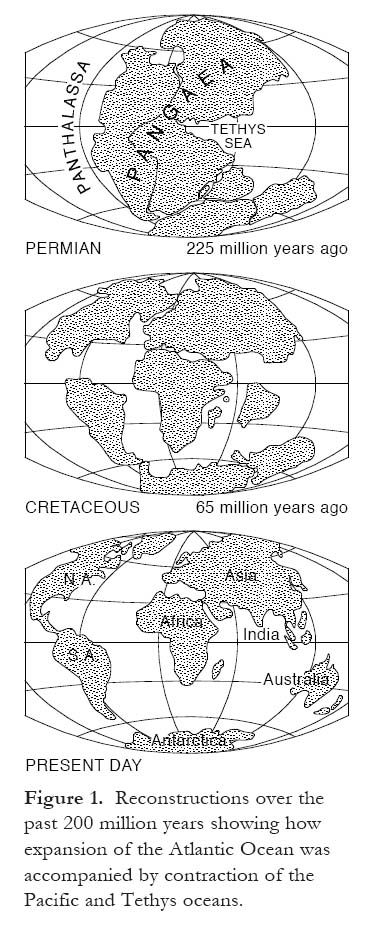
Display large image of Figure 1
4 As oceanic crust is denser than continental crust, subduction preferentially removes the oceanic lithosphere along convergent plate boundaries where continental and oceanic crust is juxtaposed. Where two oceanic plates meet at a convergent boundary, the older (and therefore denser) oceanic lithosphere is preferentially subducted. The net effect is that subduction efficiently removes old oceanic litho-sphere. So, despite the fact that the stratigraphic record of marine deposits indicates the existence of oceans as far back as the Early Archean, the oldest intact oceanic lithosphere preserved in modern ocean basins is less than 200 million years old. Continental crust has a much greater preservation potential than oceanic crust. Continental crust older than 200 million years is common, and Archean crust between 3.5 and 4.0 billion years old is preserved in the ancient shield areas of several continents (e.g. Bowring and Williams 1999).
Figure 2. Modern plate boundaries showing the distribution of volcanoes. Volcanoes on the upper plate near convergent boundaries are subduction-related. Note the concentration of volcanoes around the "Pacific Ring of Fire".
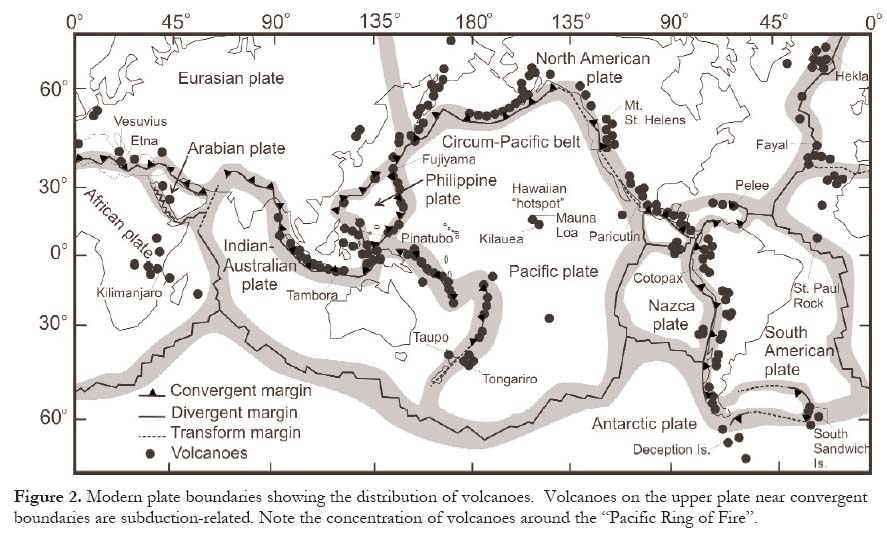
Display large image of Figure 2
5 The location of subduction zones beneath the surface is defined by an inclined zone of seismic activity, which extends to about 700 km depth. Around the Pacific "Ring of Fire", the angle of subduction varies from near vertical to subhorizontal, and is generally steeper in the western Pacific than in the eastern Pacific (Pilger 1981). This angle depends on a number of factors, including the age and thickness of the subducting lithosphere, and the motion of the upper plate (e.g. Bird 1988; Gutscher et al. 2000; Gutscher 2002). The shallower angles of subduction on the eastern Pacific margin are generally attributed to the subduction of younger (and therefore more buoyant) oceanic lithosphere, subducting oceanic plateaus (e.g. Dixon and Farrar 1980; Pilger 1981; Murphy et al. 1998; Gutscher et al. 2000; Yáñez et al. 2001; Collins 2002) and/or the westerly migration of the North American and South American plates (Bird 1988; Ramos et al. 2002). Irrespective of the subduction angle, the descending slab overwhelmingly consists of oceanic lithosphere. Sediments deposited in the trench, however, can also be dragged down the subduction zone to considerable depths. In addition, in some regions, such as in the Andes of western South America, parts of the upper plate can be sliced off and dragged down the subduction zone, a process known as subduction erosion (Stern 1991). Upper plate crust can be entrained in the subduction zone and contribute to the chemistry of arc-related magmatism.
Volcanic Arcs
6 The effect of subduction zones on crustal evolution is preserved in the tectonic evolution of the plate above the subduction zone (upper plate) where there is a relatively predictable zonation (Fig. 3). At some distance from the trench, an arcuate chain of volcanoes, or volcanic arc, is developed above the subduction zone, fuelled by magma rising from above the subducting slab.
7 Modern arcs tend to expose the surface or near-surface expression of arc magmas and so are dominated by lava and pyroclastic deposits and some feeder dykes and sills. Beneath a volcanic arc, however, are magma chambers that are a complex labyrinth of intrusions, which represent the interior of the arc plumbing system (Marsh 1988). In many ancient arc systems, uplift and erosion have removed much of the volcanic arc, so that the crystallized products of the magma chambers are exposed as large plutonic bodies, typically of granitic to dioritic composition. Therefore, to obtain a comprehensive view of arc magmatism, it is necessary to combine data from modern and ancient arcs.
Figure 3. Styles of subduction at a convergent plate boundary. Open arrows indicate motion vectors of the descending plate. a) Subduction of denser (and older) oceanic lithosphere beneath less dense lithosphere to create an island arc. The less dense lithosphere may consist of younger oceanic lithosphere (e.g. Marianas) or may be capped by continental crust (e.g. Japan). Roll-back of the subduction zone may create a backarc basin. b) Subduction of oceanic lithosphere beneath a continental margin (e.g. Andes). In both scenarios, dehydration reactions cause blueschist and eclogite facies to form at depth in the vicinity of the subducted slab. Water released from these reactions invades the overlying mantle wedge causing melting in the mantle. Rising mafic magmas may underplate the crust (modified after Tatsumi and Eggins 1995). (SCLM - Sub-Continental Lithospheric Mantle)
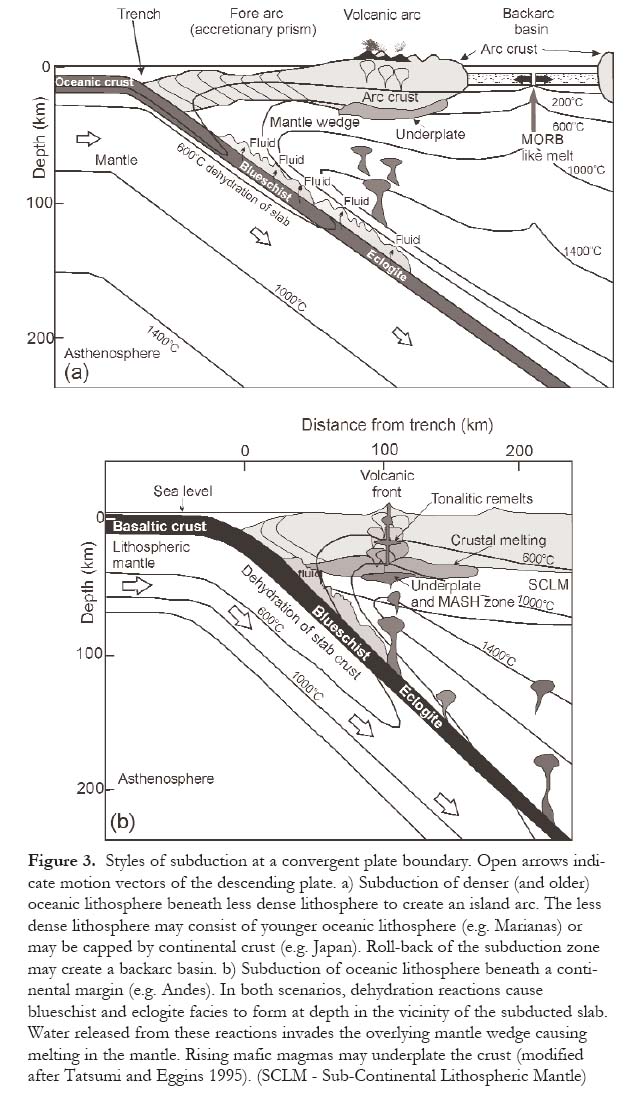
Display large image of Figure 3
8 There are two types of volcanic arcs; i) island arcs (Fig. 3a), which are an arcuate chain of volcanic islands outboard of a continental landmass, like those in the modern western Pacific Ocean, which are situated in the overriding upper plate above the subduction zone; and ii) continental arcs (Fig. 3b) like the modern Andes, which are a chain of active volcanoes on the edge of a continental landmass.
9 Island arcs may be subdivided depending on whether they are capped by a mafic crust, like the Philippines, or by continental crust, like Japan or northern New Zealand (Fig. 3a). This distinction has a profound affect on the petrological evolution of the arc magmas (Gill 2001). Island arcs capped by mafic crust tend to be dominated by mafic to intermediate magmas; those capped by continental crust have a higher proportion of intermediate to felsic lavas, and are compositionally similar to continental arcs (e.g. Miyashiro 1974). Although island arcs are typically 200-300 km wide and up to 2000 km long, volcanism at any one time is typically concentrated in a region about 10 km wide, and about 110 km above the subduction zone. However, as the dip of the subduction zone varies over its lifespan, so too does the location of the volcanism. Over a long period of time, therefore, a broad band of arc-volcanic rocks can be produced, even though only a relatively narrow band is active at any one time.
10 Also, island arcs are segmented into belts up to 300 km long, which are terminated by deep-penetrating fractures that accommodate along-strike variations in the dip of the subduction zone. Magmatism in the vicinity of these fractures has chemical and isotopic features that are different from typical arc magmas, and may reflect local upwelling of underlying asthenosphere (e.g. Marsh 1979, 1982; Kay et al. 1982). Other patterns of arc volcanism are rarer. For example, a secondary narrow chain of volcanoes may occur about 175 km above the subduction zone (Marsh 1979, Tatsumi and Eggins 1995).
Products of Arc Magmatism
11 Because of their lower viscosity, eruptions of mafic lavas are generally not explosive and produce broad volcanic structures that have gentle slopes. Intermediate and felsic magmas in volcanic arcs, however, are viscous, and move so slowly that most of the magma cools underground forming large plutons of granite and diorite (e.g. Clarke 1992, Pitcher 1993). As viscous felsic magma rises toward the surface, the reduced pressure results in the formation of gas bubbles that eventually cause the magma to explode into hot fragments (Cashman et al. 2000). Where this magma does extrude, its high gas content usually causes violent explosions, which produce steep-sided volcanoes that eject far more airborne fragments than lava, and result in pyroclastic deposits such as volcanic breccia, tuff and ash. Such explosive activity propels mixtures of gases, or aerosols, together with fragments of hot magma and wall-rock into the air. When this mixture becomes too dense to be vented upward, it collapses under its own weight, producing a rapidly moving, ground-hugging avalanche known as a pyroclastic flow that can spread as far as 100 kilometres from the site of the eruption (Sparks et al. 1973). Because of their explosive character and high velocity (typically between 50 and 200 km/hr), pyroclastic flows have claimed many lives in recorded history.
12 In contrast to the gentle slopes associated with mafic volcanoes, eruption of intermediate to felsic lavas produces dramatic volcanic edifices, including composite volcanoes, which consist of alternating layers of pyroclastic deposits and lava flows that may be erupted from either the central vent or along the flanks of the volcano. This alternation reflects the varying style of eruption over time and is a characteristic of the Cascade Range, in the Pacific Northwest. Calderas up to 100 km across are found at the summits of these volcanoes. The volume of pyroclastic material associated with a single eruption can be substantial and its effects can be global. In 1991, the eruption of Mount Pinatubo in the Philippines jettisoned an estimated 5 cubic kilometres of debris into the atmosphere, 5 times more than the volume of debris associated with the 1980 eruption of Mount St. Helens. An eruption in the vicinity of Lake Taupo, New Zealand in 1881, is estimated to have ejected between 30-50 cubic kilometres of debris in just a few minutes. Some pre-historic eruptions are estimated to have ejected as much as 2500 cubic kilometres of debris and may have had significant impact on climate.
Fore-arc
13 The region between the volcanic arc and the trench is known as the fore-arc (or "arc-trench gap", Fig. 3a), the width of which depends on the dip of the subduction zone. In steeply dipping subduction zones, the fore-arc is narrow, whereas in more shallowly dipping subduction zones, the fore-arc is wide. The fore-arc, therefore, is generally much narrower in Western Pacific, compared to Eastern Pacific, arc systems. This relationship is generally interpreted to indicate that the subduction zones must attain a certain depth (about 110 km) before processes in them trigger the generation of arc magmas. The frontal part of the fore-arc may contain pyroclastic deposits, lavas or immature volcaniclastic sediments, all derived from the active part of the arc, which rest upon a basement of igneous and metamorphic rocks. Near the trench, the fore-arc exhibits complex deformation as sediments deposited in the trench are scraped off the downgoing plate and are plastered onto the inner trench wall to form an accretionary prism. As the accretionary prism grows, the trench migrates, which in turn can result in migration of the locus of arc magmatism. Alternatively, fore-arc material can be transferred from the overriding plate to the subducting plate by subduction erosion and may then be transported down the subduction zone (cf. Stern 1991, 2002). Subduction erosion occurs on more than half of the modern convergent plate boundaries, especially where the overriding plate is moving rapidly towards the subduction zone and the width of fore-arc in these regions is less than that predicted by the dip of the subduction zone. High pressure, coesite- (e.g. Schreyer 1988) and diamond-bearing (Xu et al. 1992) meta-morphic rocks in subduction zone complexes indicate that crustal material can be subducted to depths of at least 100 km. The preservation of high pressure minerals in low-grade metamorphic rocks requires more rapid exhumation of arcs than the relatively slow erosion-controlled exhumation, and is generally interpreted to reflect tectonic thinning processes (e.g. Brown 1993). Additional evidence that subducted material is recycled by the subduction zone processes is provided by the chemical and isotopic composition of arc magmas (Murphy 2007).
Backarc
14 Although the precise mechanisms are controversial, the region behind the arc may be either in extension or compression. There may be several mechanisms responsible for backarc extension, but the currently popular model is the roll-back model (Dewey 1980). This model proposes that as the disconnected end of the dense slab collapses into the asthenosphere, it may "roll-back" oceanward (Fig. 4). The retreat of the slab is associated with seaward migration of the trench and causes extension in the upper plate. Therefore, subduction zones may move appreciably over timescales of 100 million years relative to some other reference frame. Subducting slabs sink more steeply than the inclinations of Benioff seismic zones, which mark transient positions, not trajectories, of slabs. The convergent margin can move faster than the roll-back if the upper plate is also moving over the descending one, as in the case of the westward drift of North America since the break-up of Pangaea. Episodic subduction occurred along the western margin of North America over the past 100 million years, demonstrating significant motion of subduction zones.
Figure 4. Diagrams illustrating how arcs switch from compressional to extensional tectonic settings (Collins 2002). Roll-back of the subduction zone results in the generation of an inter-arc rift (A) followed by a backarc basin (B). Eventually, the subduction zone overrides an oceanic plateau (B to C) which results in shallowing of the subduction zone and backarc basins formed by extension become inverted. After the oceanic plateau is completely overridden, more angled subduction, roll-back and inter-arc basin development resumes (D).
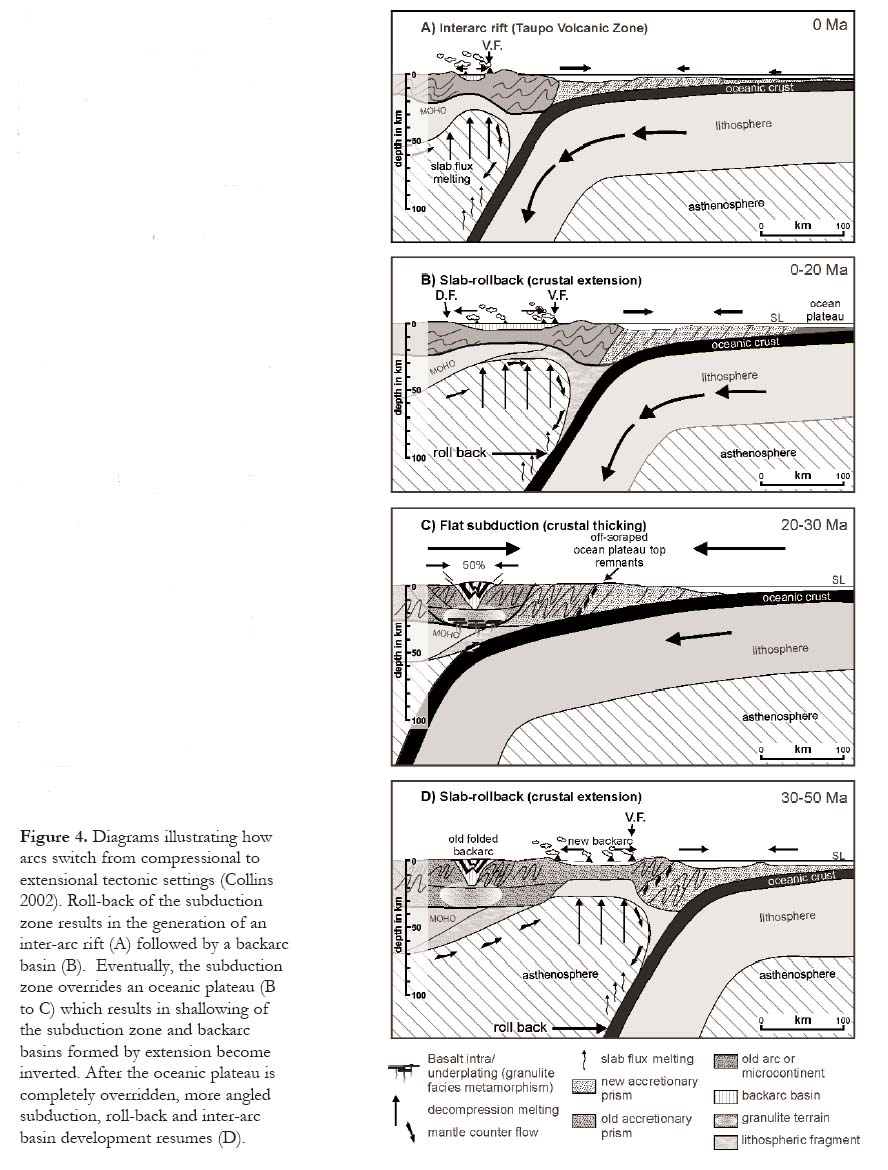
Display large image of Figure 4
15 Roll-back is most effective where old oceanic lithosphere is subducted, and extension in the upper plate results in backarc spreading, in which a backarc basin (also known as a marginal basin) opens up behind the arc. This style of subduction predominates in the western Pacific Ocean, where backarc basins separate island arcs from the Asian continent. For example, the Sea of Japan and the West Philippine Basin are backarc basins that separate the island arcs of Japan and the Philippines from the Asian mainland. As these basins are floored by oceanic crust, it is not surprising that the pillow lavas produced are similar mineralogically and texturally to mid-ocean ridge basalts (MORB). Backarc basins, however, lack the classical, well-defined magnetic anomaly patterns of MORB, possibly because the rifting is asymmetric and the magmatism is diffuse (e.g. Uyeda 1978). According to Collins (2002), extension and decompression associated with roll-back may result in asthenospheric upwelling and voluminous magmatism in the overlying mantle and crust. In most cases, geochemical and isotopic investigations reveal the influence of a nearby arc on the composition of the mantle source.
16 In the geological record, vestiges of ancient backarc basins also may be distinguished from mid-ocean ridge settings by the character of the sedimentary strata associated with the basalts. As backarc basins fringe volcanic arcs on one side and a continental land mass on the other, they may contain abundant volcaniclastic sediments that are cannibalized from the adjacent arc or clastic sediments derived from the continental hinter-land. In contrast, most mature midocean ridge settings are sediment-starved; consequently, chemical (e.g. chert) and pelagic sediments predominate.
17 For continental arcs with backarcs in extension, regions of thinned continental crust are produced in which the rise of hot mantle towards the surface generates crustal melts as well as melts from the decompressed mantle. For example, in the Taupo Volcanic Zone of northern New Zealand, the crust is as little as 5 km thick with partially molten material, thought to be the source of the magma, immediately below (Cole et al. 1998, 2005). Magmas in continental backarcs are commonly bimodal in composition (i.e. they are dominated by basalt and rhyolite, with few "intermediate" rocks) and are associated with high temperature–low pressure metamorphic belts and possibly meta-morphic core complexes (e.g. Hyndman et al. 2005).
Profile of the Subduction Zone
18 Subduction zones are not static; they may migrate (shallow or steepen) as the age or thickness of the subducted lithosphere, or as the relative motion of the converging plates, changes (e.g. Molnar and Atwater 1978; Hynes and Mott 1985; Ramos and Aleman 2000; Gutschner et al. 2002). As the dip and location of a subduction zone change, so too do the width of the arc-trench gap and the locations of the volcanic arc and the backarc basin. If plate convergence is high and young, and/or buoyant oceanic crust is being subducted, the subduction zone becomes sub-horizontal, and is too shallow to generate arc magmas (Dickinson and Snyder 1979; Pilger 1981; Bird 1988; Ramos et al. 2002; English et al. 2003). Such an environment occurs in several segments of the modern Andes (Fig. 5). Although much of the Andes is a classic continental arc, there are narrow segments where no modern magmatism occurs. Seismic images reveal that beneath these segments the subduction zones are sub-horizontal. Pilger (1981) drew attention to the correspondence between these zones and the subduction of thick and buoyant oceanic plateau (Fig. 5).
19 Backarc regions in compression occur predominantly in continental settings where compression of a thermally softened crust can lead to polyphase deformation and both thick-skinned and thin-skinned fold-and-thrust belts (Ramos and Aleman 2000). Much of the backarc region of the Andes is currently in compression and is undergoing active deformation. Continental backarcs are characterized by thin hot lithosphere and have Moho temperatures of ca. 850°C and lithospheric thickness of ca. 55 km, compared to ca. 450°C and 150-300 km, respectively, for adjacent cratons (Fig. 6, Hyndman et al. 2005). Continental backarcs are hotter, and therefore, an order of magnitude weaker than adjacent lithosphere. In addition, these basins may contain thick deposits of sediments that are fertile material for the formation of crustal melts. Taken together, backarc basins may well be the sites where magmatism and high-grade metamorphism develop more readily than in adjacent, drier rocks, and so may exert a fundamental control on the petrology of magmas produced in arc systems (Collins 2002; Hyndman et al. 2005). In support of this model, Collins (2002) points out that the mineralogy of many granulite facies complexes requires geothermal gradients between 20° and 50°C per km, which is much higher than gradients in collisional environments, but is consistent with those expected in backarc settings.
20 Backarc regions in continental environments may alternate between periods of extension and compression (known as "tectonic switching", Collins 2002). Backarc basins that result from extension induced by periods of rollback and slab retreat can intermittently become inverted and polydeformed by compression, induced by flat-slab subduction related to arrival at the trench of an oceanic plateau (Fig. 4). During the extensional phase, the high geothermal gradient and ascending mafic magma induce crustal melting and high-grade (granulite-facies) metamorphism.
21 In a general sense, subduction zones, and therefore arc magmatism, can last for hundreds of millions of years. The processes that result from prolonged subduction profoundly affect the composition, thickness and strength of the lithosphere. Uplift associated with this tectonothermal activity is not continuous, but instead appears to be episodic. For example, although subduction and magmatism have persisted along the western margin of South America for most of the last 200 million years, it was only about 15 million years ago that the rate of uplift was sufficient to reverse the flow of the Amazon river from its ancestral westward path into the Pacific Ocean to its current eastward path into the Atlantic Ocean (e.g. Hoorn et al. 1995). Many geoscientists attribute this rapid uplift to the effect of higher rates of compression between the converging South American and Pacific plates on a crust that was thermally weakened by prolonged arc-related magmatism (Ramos and Aleman 2000). Arc magmatism can be pre-kinematic, syn-kinematic and post-kinematic with respect to discrete deformational events.
Figure 5. Andean arc magmatism, and the correspondence between sub-horizontal subduction zones and the overriding of oceanic plateau (see Pilger 1981; Yáñez et al. 2001; Ramos et al. 2002). The bars indicate regions where no active volcanism occurs. These regions are above subhorizontal subduction zones.Heat Flow
22 The subducting slab, the region of arc magma generation, and the varied components of backarc regions can all be detected by surface heat flow measurements across oceanic and continental arc systems (Fig. 6). Heat flow is low, both in the vicinity of the trench and in the arc-trench gap (fore-arc), reflecting the descent of cold oceanic lithosphere into the mantle and the absence of convecting mantle between the fore-arc and the subducting plate. The effect is similar to that of immersing an ice cube into hot tea. For the time it takes for the heat to be transferred from the tea into the ice, the ice remains anomalously cold. Similarly, the temperature in, and adjacent to, the subduction zone is lower than the surrounding mantle at the same depth. As a result, the geothermal gradient (the increase in temperature with depth), and therefore, the heat flow to the surface, are low in the vicinity of subduction zones. The geothermal gradient can be as low as 10°C/km, and the heat flow as low as 0.05 W/m2.
23 In contrast, the region beneath volcanic arcs is dominated by high heat flow. Volcanic activity accounts for about 10% of this anomaly and the remainder is attributed to the ascent of hot magma towards the surface and/or mantle convection (Gill 1981). As the region below the arc is hotter than the surrounding rocks, heat flow measurements are high (up to 0.1 W/m2) and the geothermal gradient is steep (typically 30°C/km).
24 Until recently, it was thought that heat flow in the backarc depended on whether it is under extension (high heat flow) or compression (low heat flow). Extensional backarcs are hot, irrespective of whether they are floored by oceanic (e.g. Western Pacific) or continental (e.g. Basin and Range) crust (Wiens and Smith 2003). However, Hyndman et al. (2005) point out that many modern non-extensional backarcs have heat flow values that are comparable with the region beneath volcanic arcs, and are twice that of the adjacent cratons (0.04 W/m2, Chapman and Furlong 1992). The reason for the high heat flow in such backarcs is unclear. However, as many geodynamic models treat shortening as being geologically instantaneous (e.g. England and Thompson 1986), it is possible that some of these backarcs may have inherited the high heat flow from a recent history of extension (from which the heat has yet to dissipate) and switched to compression by the arrival of a microcontinent or oceanic plateau at the subduction zone.
Figure 6. Heat flow profiles across the Cordilleran volcanic arc showing high heat flow in the backarc region (after Hyndman et al. 2005).ASCENT OF ARC MAGMA
25 Three fundamental properties influence the rate at which arc magma ascends: i) magma is less dense than the wall rocks and is, therefore, buoyant, ii) a magma with lower viscosity rises with greater ease than a more viscous magma (therefore, mafic magma generally rises more readily than felsic magma, which is likely to be trapped in magma chambers where it cools to form a pluton), and iii) magma rises more rapidly in an extensional environment than in a compressional setting because widening fractures create space for rising magma to exploit.
Mechanisms of Intrusion
26 In arc environments, vast volumes of magma rise toward the surface, and this magma must occupy space that was previously occupied by solid rock. Unlike continental rifts, in which regional crustal extension provides space for ascending magma, in arc environments the "room problem" (see Paterson et al. 1991) is still controversial after more than a century of debate. Although, to some extent, this space problem applies to all tectonic settings, it is particularly acute in arc settings where compressional tectonics predominates, and crustal thickening impedes the ascent of magmas. The less efficient ascent of magmas in arc settings has important petrological consequences because such environments promote extensive magma-wall-rock interaction and cooling, factors that explain the abundance of plutonic rocks in arc environments.
27 Where sufficient magma is produced (> 15%), it congregates and attains buoyancy because it is less dense than the surrounding rock, particularly in the lower crust which is more ductile than the upper crust. Experiments show that magma may attain enough buoyancy to rise from large magma chambers as tear-drop shaped bodies (diapirs) with regular spacing between them (Fig. 7; Marsh 1982; Miller and Paterson 1999; Johnson et al. 2001) or as nested diapirs (Paterson and Vernon 1995). For example, volcanic centres in the Central American arc are typically spaced about 25 km apart, and are thought to be the result of diapiric uprise from a larger pool of magma that parallels the length of the arc (Marsh 1979; Gill 1981). Although field observations indicate that diapirs can arch the over-lying layers, most petrologists contend that this process acting alone is unlikely to enable magma to rise into the shallow brittle crust (Hutton 1988; Pitcher 1993). The rise of a diapir is self-limiting because its buoyancy decreases as it rises (the density of rocks surrounding the magma decreases as the surface is approached and magma becomes denser as it cools).
28 An alternative mechanism for the upper crust proposes that magma rises by assimilating the overlying rocks. The occurrence of partially digested xenoliths in many arc-related intrusive rocks lends support to this hypothesis. However, most petrologists are still swayed by Bowen’s (1928) elegant arguments that magmas do not have sufficient heat content to digest large quantities of host rock, and the loss of energy in the digestion process causes the magma to cool and crystallize, rather than rise. Geochemical and isotopic data from many plutons also argue against significant assimilation of local wall rocks (e.g. Glazner and Bartley 2006).
29 Magma may be able to create and exploit cracks and fractures in the overlying crust. Experiments show that melting results in a 15 percent increase in volume, and this expansion may produce enough pressure to fracture the overlying rock and allow the magma to rise. The presence of water in the arc magmas enhances its ability to create fractures (see Downey and Lentz 2006). Magma will also increase in volume if it rises sufficiently fast that it does not lose much heat (i.e. adiabatically). The resulting expansion of the magma may also result in fracture propagation that weakens the resistance of overlying rock.
Figure 7. The ascent of arc magma (modified after Pitcher 1993). By (A) diapirism, (B) exploiting faults, (C) stoping involves the foundering of wall rock into the magma chamber, (D) exploitation of structures such as local extension or pull-apart faults. These mechanisms may work in concert as rising diapirs of magma may exploit zones of crustal weakness, such as faults and extensional zones in those faults. In these zones, wall rocks are weakened, promoting stoping. One of the main features of stoping is the presence of abundant xenoliths (see inset).
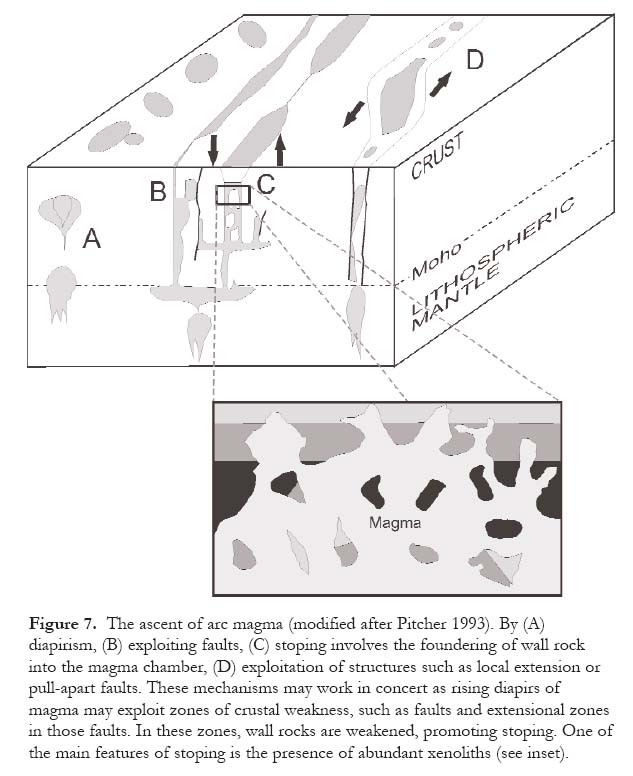
Display large image of Figure 7
30 The foundering of overlying blocks into the magma, (Fig. 7), called stoping, is enhanced by the tendency for magma to invade fractures in the host rocks and pry them loose so that they drop into the magma (e.g. Marsh 1982). Evidence supporting this process includes the occurrence of large xenoliths in plutonic rocks. However, it is unclear how important this process is in facilitating the ascent of magma over long distances (see Clarke et al. 1998). In addition to the lack of geochemical and isotopic evidence for significant assimilation, the fact that xenoliths are volumetrically small, even on pluton floors and that large plutons grow incrementally from small batches of magma (blocks can only fall through liquid magma) together suggest that stoping is not a significant method of pluton emplacement (Glazner and Bartley 2006).
31 Field observations demonstrate a close relationship between igneous intrusions and adjacent faults (Fig. 7) suggesting that magma exploits large-scale crustal weaknesses (e.g. Sawyer 1994). Fractures associated with faulting may, therefore, be favourable locations for magma emplacement (Fitch 1972) and significant volumes of magma can migrate through them (e.g. Clemens 1998; Brown and Solar 1998). A magma intruded into an extensional tectonic environment, for example, can exploit opening fractures that create space for it. Extensional environments can occur locally in arc settings, especially where a fault within the arc bends or jogs (e.g. Guineberteau et al. 1987; Hutton 1988; Murphy and Hynes 1990; Koukouvelas et al. 2002; Fig. 7) and magma ascent is especially rapid in such environments.
Extensional Regimes
32 A number of recent studies on modern arcs have indicated the importance of extensional regimes in the generation of arc magmas (e.g. Hyndman et al. 2005) and that the composition and ascent of these magmas are profoundly influenced by faults and fractures whose orientation reflects plate boundary conditions (Tibaldi 1992; Spinks et al. 2005). For example, Tibaldi (1992) shows that these environments generate wide belts of magmatism, and Spinks et al. (2005) show that the regions with the greatest extension in the Taupo Volcanic Zone of New Zealand produce active calderas up to 50 km wide that are dominated by felsic magmatism, whereas areas with the greatest transtension produce less active andesitic stratovolcanoes. The implication is that these varying structures provide conduits to magmas ascending from different structural levels. Paterson and Tobsich (1992) and Petford et al. (2000) show that strain rate along these structures influences magma composition and eruption style.
33 Several studies emphasize the importance of intra-arc strike-slip tec-tonics in controlling the rise of magmas in modern arcs (e.g. central Andes: De Silva 1989; NE Japan: Sato 1994; Ecuador: Tibaldi and Ferrari 1990; Mexico: Tibaldi 1992; Kamchatka: Baluyev and Perepelov 1988). This is similar in principle to example D in Figure 7, where the strike-slip fault occurs within an arc setting. Magmatism in the Kamchatka Volcanic Belt, for example, is associated with regional transcurrent faults that reach a depth of 40 km and it is suggested that the depth of magma generation is controlled by these faults (Baluyev and Perepelov 1988). Tibaldi (1992) attributes the obliquity between the Mexican Volcanic Belt and the Middle American Trench to transcurrent motion along adjacent faults. According to Ferrari et al. (1989), deep penetrating faults in intra-arc environments create favourable conditions for rapid ascent of mafic magmas with little crustal contamination.
Batholiths
34 Field studies of large batholiths in arc regimes show that they represent the vestiges of voluminous magma chambers in the middle and upper crust (e.g. Clarke 1992; Pitcher 1993; Coleman et al. 2004; Miller and Paterson 2001; Vigneresse and Bouchez 1997) that were constructed incrementally by repeated injection from elongated dykes (Hutton 1992; Miller and Paterson 2001) or were emplaced as nested diapirs (Allen 1992; Paterson and Vernon 1995). These batholiths, therefore, are composite and have numerous internal contacts that vary from sharp and planar to gradational and irregular. A recent study of the Tuolumne Batholith of the Sierra Nevada (9 Zák and Paterson 2005) proposes that its evolution involved fractional crystallization, magma mixing on a kilometre-scale, stoping along sharp contacts, and downward return flow (and/or margin collapse) of older magma units, with dyke injections becoming important locally during the later stages.
35 It appears that several mechanisms may act in concert to facilitate the rise of arc magmas. Many diapirs are located near fault zones and appear to have exploited zones of crustal weakness. Magma exploiting such zones may rapidly rise and expand, resulting in fracture propagation, facilitating stoping and assimilation. As fracture zones are repeatedly exploited, the net result may be a composite batholith that typifies arc systems.
EFFECT OF WATER
36 Perhaps the most unifying characteristic of arc magmas is the important role played by water in all stages of magma evolution, including magma genesis, ascent toward the surface, cooling and crystallization, and during volcanic eruptions. The explosive nature of arc volcanic eruptions, the abundance of vesiculated products such as pumice and phenocrysts of hydrous mineral phases are all indicative of magmas with high volatile content.
Water in the Mantle Wedge
37 The subducted slab of oceanic litho-sphere contains abundant water, and as it descends into the mantle it is warmed and undergoes prograde dehydration reactions. According to Tatsumi and Eggins (1995), the release of water from prograde dehydration reactions occurring in the slab (amphibolechlorite assemblage at 110 km depth, phlogopite at 175 km depth) may be responsible for two parallel volcanic arcs. The released water is a supercritical fluid under mantle conditions, and has the capacity to extract soluble elements from the slab (e.g. K, Rb, Ba, Sr, U, Pb, Th and Cs, known as the large ion lithophile elements or LIL), which are transported to, and become enriched in, the overlying mantle wedge (e.g. Spandler et al. 2003; Leibscher 2004).
38 The fluid that invades the mantle wedge plays a pivotal role in generating arc magma (Fig. 3, Peacock et al. 1994). It is a general principle of igneous petrology that water lowers solidus temperatures of the mantle. So the relentless invasion of water into the mantle wedge promotes melting and the generation of arc magmas. The presence of water affects the stability of silicate and accessory minerals at the site of melting and during subsequent cooling. Water content influences magma composition, chemical evolution and the kinetics of mineral growth. The combination of these effects can be recognized in the miner-alogy, textures, geochemistry and isotopic signature of arc magmas.
39 Even a small amount of water lowers the melting temperature (or the solidus) of rocks (Fig. 8). Common mantle minerals such as garnet, olivine, orthopyroxene and clinopyroxene do not readily admit water into their crystal structure (this tendency is reflected by the lack of water in their mineral formulae). Because the water molecule is polar, the negative end of the molecule tugs on the cations of minerals, weakening their bonds. The weakened crystal structure requires less energy to break the bonds, and so magma can form at a lower temperature than under dry conditions. This effect is especially profound in the mantle, where dry rocks are resistant to melting because the elevated pressure reduces bond lengths and favours more dense mineral structures. However, at these pressures, water’s ability to weaken crystal structures becomes even greater, so that wet rocks become less resistant to melting with increasing depth.
40 In addition to weakening the crystal structures, water ascending from depth is a heat flux because it rises rapidly and does not lose much heat to its surroundings. The combination of weakened mineral structures and additional heat promotes melting and the formation of magma in the overlying mantle wedge and in the crust.
Figure 8. The effect of water on magma genesis. Phase diagram emphasizing the role of water in magma source rock (modified from Winter 2001) showing a comparison between the dry and water-saturated solidi for granite, basalt and peridotite, and typical shield and oceanic geotherms. The breakdown curves for hydrous phases in the mantle such as amphibole and phlogopite are shown.Potential Significance of Mineral-Fluid Interaction in the Mantle Wedge
41 In the mantle wedge, fluid rising from the subduction zone interacts with minerals and fluids already present. Thus, the fluid composition at the site of melting probably has components of both the invading fluid from the subduction zone, the indigenous fluid previously added to the mantle wedge, and fluid released by mantle minerals. In addition, some elements are released from the mineral into the fluid but other elements present in the fluid may be incorporated in a solid phase.
42 Several experiments have demonstrated that the composition of igneous melts is profoundly influenced by fluid composition at the site of melting (e.g. Mysen and Boettcher 1975; Boettcher 1977) with higher H2O content resulting in silica-saturated basalts, and higher CO2 content leading to the generation of silica-undersaturated basalts. In addition, fluids derived from the dewatering of the slab invade and react with minerals in the mantle wedge, promoting the formation of minerals that permit water into their crystal structure, such as hornblende and phlogopite. For the most part, these fluids migrate along grain boundaries. The resulting solution and precipitation of mantle minerals affects the bulk partitioning of trace elements between mantle minerals, fluid and the melt.
43 These findings suggest that an understanding of the factors that affect this fluid composition is essential. Although these factors are poorly understood, generalized phase relationships shown schematically on isothermal-isobaric diagrams illustrate the importance of understanding fluid-mineral interaction (Fig. 9; modified after Eggler 1978; Thompson 1983; Murphy 1989). These diagrams focus on the relationship between non-volatile phases (A), hydrous phases (H) and carbonate phases (C). Hydration reactions are represented on the AH join, carbonatization reactions on the AC join, and fluid composition on the CH join (Fig. 9a). Mantle rocks may contain several hydrous and carbonate phases (e.g. phlogopite, amphibole, calcite, and dolomite) with varying degrees of hydration and carbonatization. For simplicity, individual hydrate and carbonate phases are not displayed as they do not affect the following arguments. The stippled triangle in Figure 9a represents an assemblage with no free fluid phase (i.e. volatile-absent, see Thompson 1983). For bulk compositions within that triangle, fluids injected become absorbed in hydrate (H) or carbonate (C) phases. With increasing temperature, the reactionC+H 6 A+fluid
occurs and anhydrous phases exist in equilibrium with a fluid (as shown in Fig. 9b).
44 Incremental input of a CO2-rich fluid (G, Fig. 9a) into a rock of bulk composition J would result in progressive dissolution of anhydrous phases (path 1, Fig. 9a). If the ratio of hydrate to carbonate phases in the host rock is less than the CO2/H2O ratio of the fluid, then dissolution of the hydrate-bearing phases (H) will occur via the continuous reaction:A+H+G (fluid) X C
45 A free fluid phase would only occur after expiration of A (X, Fig. 9a). Further input of fluid G would result in continued precipitation of C and dissolution of H (path X to Y). The fluid produced by this reaction is buffered (at constant pressure and temperature) to constant composition P, which is different from the composition of the invading fluid. This continuous reaction is:H+G (fluid) X C + P(fluid)
i.e. fluid G is spontaneously converted to fluid P.
46 Note that in this case the reaction may be irreversible if fluid P is lost (e.g. through partitioning into magma). If fluid loss occurs when the bulk composition is at R, then the bulk composition is deflected from path 1 along path 2 which projects through R to P (i.e. a path of constant C/H). If the bulk composition continues along path 1, then buffering of the fluid phase to composition P is lost when the hydrate phase expires (Y, path 1). At this stage, magma of different composition may be produced.
Figure 9. The effect of the introduction of fluids into a potential source rock (see Murphy 1989). Schematic representation depicting phase relationships between a volatile-absent phase A, a hydrous phase H, a carbonate phase C and fluid. Modified after Eggler (1978). The stippled triangle in (a) represents the fluid-absent region (see Thompson 1983) and the stippled triangles in (b) are zones of invariant vapour composition (Eggler 1978). Within the stippled triangles of (b) fluid composition is held constant during influx of exotic fluid by re-adjustment in the modal abundances of the phases at the apices of the compositional triangle.

Display large image of Figure 9
47 Input of CO2-rich fluid (G, Fig. 9b) to the higher temperature assemblage (e.g. S) initially causes dissolution of H (path 1) and precipitation of A as the fluid is buffered to constant composition M via the continuous reaction:H + G (fluid) X A + M(fluid)
Buffering of the fluid phase would continue until H is consumed (at h, Path 1). Continued addition of fluid G would eventually lead to renewal of buffering at the first appearance of a carbonate phase C at d (path 1). Fluid loss, at an early stage along path 1, results in precipitation of A and H (between S and h), precipitation of A (between h and d) or precipitation of A and C (between d and e). Where partial melting occurs, the fluid extracted by the magma would be significantly more enriched in H2O. Extraction of a fluid F from bulk composition S (path 2, Fig. 9b), would result in continued precipitation of A and dissolution of H. Situations in which buffering is either achieved or lost involve sudden changes in the composition of the fluid, and therefore, may promote enhanced dissolution or precipitation of mantle minerals (depending on how the composition of the fluid changes).
Partial Melting in the Mantle Wedge
48 Although the introduction of water lowers solidus temperatures, there is never enough energy to completely melt the mantle wedge. Instead the mantle undergoes partial melting. Although partial melting of the mantle typically produces basaltic magma, in detail, the overall chemical composition of the basalt (especially the trace element and isotopic content) is profoundly influenced by the relative stability of minerals. The crystal structures of some minerals are more weakened than others and so some minerals are more prone to melting than others. Partial melting, therefore, proceeds in a regular fashion, and melt compositions can be predicted by phase equilibria. For example, at high mantle pressures, garnet is more stable than olivine, and so garnet stays behind in the residue, and the basalts produced are depleted in the components of garnet relative to olivine. A hydrated mantle wedge enhances the stability of several accessory minerals (e.g. zircon, titanite, and ilmenite). Because several important trace elements and REE elements are concentrated in these phases, their stability in a hydrated mantle means that arc magmas are depleted in these elements relative to, for example, rift-related magmas. This is an important chemical fingerprint for distinguishing among magmas of different tectonic environments and will be discussed in a later publication (Murphy 2007).
Partial Melting of the Crust in Continental Arcs
49 Volatile components such as water and carbon dioxide have a strong tendency to enter magmas generated in both the mantle and the crust. In many tectonic settings, the partitioning of water into magma reduces PH2O in the source rock, thereby raising the solidus temperature and limiting the amount of melt produced. This effect is schematically shown in a simplified phase diagram in the system K2O-Na2O-Al2O3-SiO2-H2O (KNASH, after Thompson and Algor 1977, Fig. 10a). The reactions depicted (Fig. 10) involve the breakdown of muscovite during the melting of pelites. Reactions 2 and 5 define the curve for minimum melting of pelite and the formation of felsic magma under water-saturated conditions (PH2O = Ptotal). In some tectonic environments (e.g. continental rifts), the condition PH2O < Ptotal may develop in the pelites such that the activity of water is less than unity (aH2O < 1). In this scenario, the univariant reactions involving water become divariant and progressively migrate as aH2O is reduced, so that the stability field of the assemblage containing water is expanded. Reactions 2, 3 and 5 move to the right, reactions 1 and 4 to the left, but reaction 6, which is the fluid-absent reaction is unchanged. Since the invariant point for a given aH2O is the intersection of the univariant curves, the invariant point slides along the vapour-absent curve (V) towards higher P and T as aH2O decreases (see Thompson and Algor 1977). The net effect is that the temperature required for melting pelites increases as aH2O decreases causing the amount of melt generated to be small (< 10%), i.e. below the critical volume required to attain the buoyancy to rise to higher levels in the crust. However, reactions involving the breakdown of biotite (Fig. 10b; generally between 750 and 780°C) may generate more magma (up to 60%, Clarke 1992), leaving a residue of granulite that is typical of arc environments (Collins 2002).
50 If no water is added, (e.g. Spear et al. 1999), then reactions that generate magma require higher temperatures to proceed as aH2O decreases, but in arc settings, the supply of water may be continuously replenished (either directly or indirectly) by ongoing dehydration of the subducting slab. As a consequence, aH2O may remain close to unity, and anatexis of crustal rocks in arc environments generally proceeds at lower temperatures, and is more voluminous than in continental rifts, and spans longer periods of geologic time, routinely tens of millions of years.
Water and the Ascent of Magma
51 Although the details are controversial, water probably plays an important role in the ascent of magmas, because it reduces the viscosity of the melt (e.g. Mysen 1988). Furthermore, water pressure also promotes fracturing in over-lying rocks, particularly in the crust. In the deviatoric stress field that is typical of arc regimes, water pressure reduces the effective stresses, which induces fracturing, as demonstrated by classic Mohr circle analysis. As water pressure builds up, the Mohr circle migrates towards the left as effective pressures are reduced, until the failure envelope is intersected. At this point fractures develop in the host rock, which facilitate the rise of magma and fluid (Fig. 11). This process is cyclic, as water pressure builds up and is then released when fracturing occurs (e.g. Sibson 1987).
Cooling History and Stability of Minerals
52 The presence of water also affects the sequence of crystallization in mafic magmas. Water content also affects stability of hydrated phases such as hornblende and biotite. Hornblende phenocrysts are common in arc lavas, and both hornblende and biotite are common in arc plutons. Experiments on the cooling history of basaltic magma formed in arc environments (Foden and Green 1992) indicate that the stability field of amphibole relative to olivine, pyroxene and plagioclase, is expanded with increasing partial pressure of water (see also Yoder and Tilley 1962). The implication is that amphibole may, in some situations, crystallize before olivine or pyroxene.
Figure 10a. Schematic phase diagram (modified after Thompson and Algor 1977) showing the melting of pelites in the system K2O-Na2O-Al2O3-SiO2-H2O (KNASH). Reactions are distributed around the invariant point (I3) according to Schreinmakers rules (see Yardley 1989, p. 217-222). For simplicity, SiO2 is assumed to be in excess, so that the Qtz-absent curve is excluded. With decreasing activity of water, I3 migrates up the vapour absent curve (V) in the KNASH system.
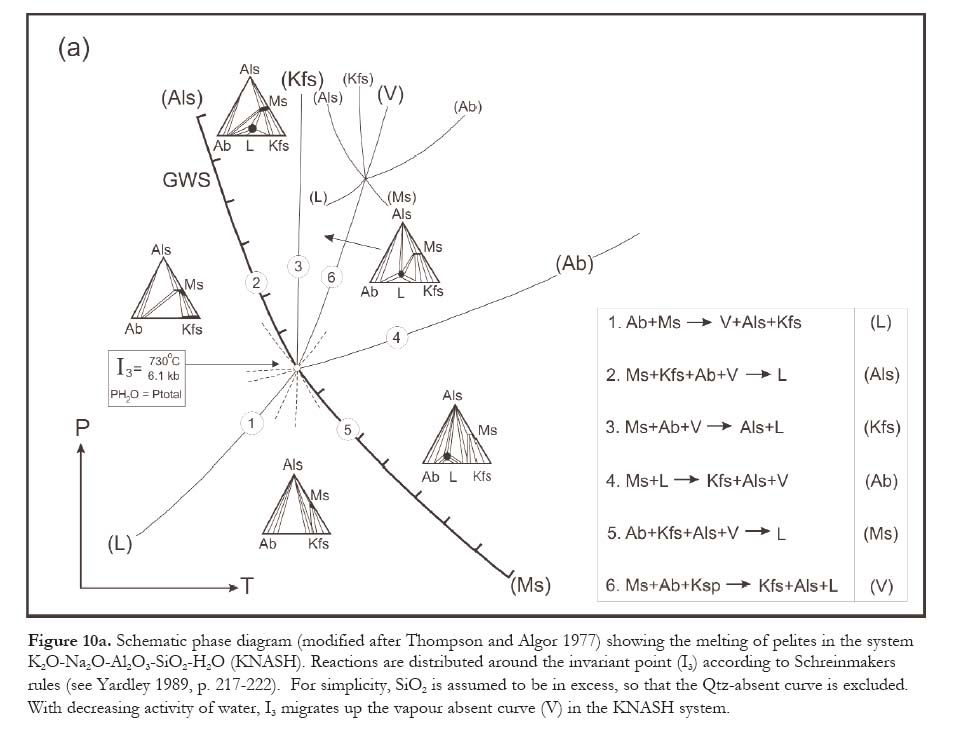
Display large image of Figure 10
53 As water is an oxidizing agent, it also affects the stability of minerals such as magnetite that contain Fe3+. In oxidized magmas, magnetite is an early crystallizing phase, reflecting the higher Fe3+ /Fe2+ content of the melt (e.g. Miyashiro 1974). The enhanced stability of these minerals greatly affects the chemical composition of arc magmas. In contrast to continental rifting environments, K-feldspar phenocrysts are rare, even in felsic rocks, because most arc magmas are not enriched in alkalies.
54 Water content in magmas also plays a key role in phenocryst development because it reduces the viscosity of the melt by breaking Si-O bonds (a process known as depolymerization). As a result, ions can diffuse more easily and minerals can grow more rapidly (Mysen 1988). Arc lavas of all compositions are characterized by relatively high proportion of phenocrysts, commonly up to 20%. Plagioclase is by far the most common phenocryst in arc magmas of all compositions and typically exhibits normal, oscillatory or reverse zoning (e.g. Stewart and Fowler 2001). At constant pressure, the composition of plagioclase is controlled by the temperature, composition and water content of the melt. If, as a plagioclase crystal grows, these conditions change, so too may the composition of the next growth increment, leading to zoning. Zoning requires that chemical equilibrium between the melt and the plagioclase is not maintained. This may be because the strength of Si-O and Al-O bonds inhibits the dissolution of plagioclase, which is required to maintain equilibrium with the cooling melt, or because of the slow diffusion of Al. Normal zoning is thought to reflect cooling of the magma, oscillatory zoning reflects abrupt changes in melt composition, possibly brought on by a new influx of magma into the chamber, and reverse zoning is thought to represent a small component of oscillatory zoning (e.g. Shelley 1993).
Figure 10b. Simplified NaFMKASH (Na2O-FeO-MgO-K2O-Al2O3-SiO2-H2O) modified from Brown (1993), Spear et al. (1999) showing important reactions in pelites that can generate silicic magma. Reactions shown for PH2O = Ptotal, SiO2 is assumed to be in excess. Note the position of each reaction in P-T space is idealized and changes as a function of aH2O (except for vapour-absent reactions) and/or Fe-Mg solid solution (where Fe-Mg bearing phases are involved). Reactions involving biotite are thought to produce magma with sufficient volume to attain the buoyancy required to rise to higher structural levels (e.g. Clarke 1992). GWS, Granite Wet Solidus (combination of reactions 2 and 5); BWS, Basalt Wet Solidus (see Brown 1993).
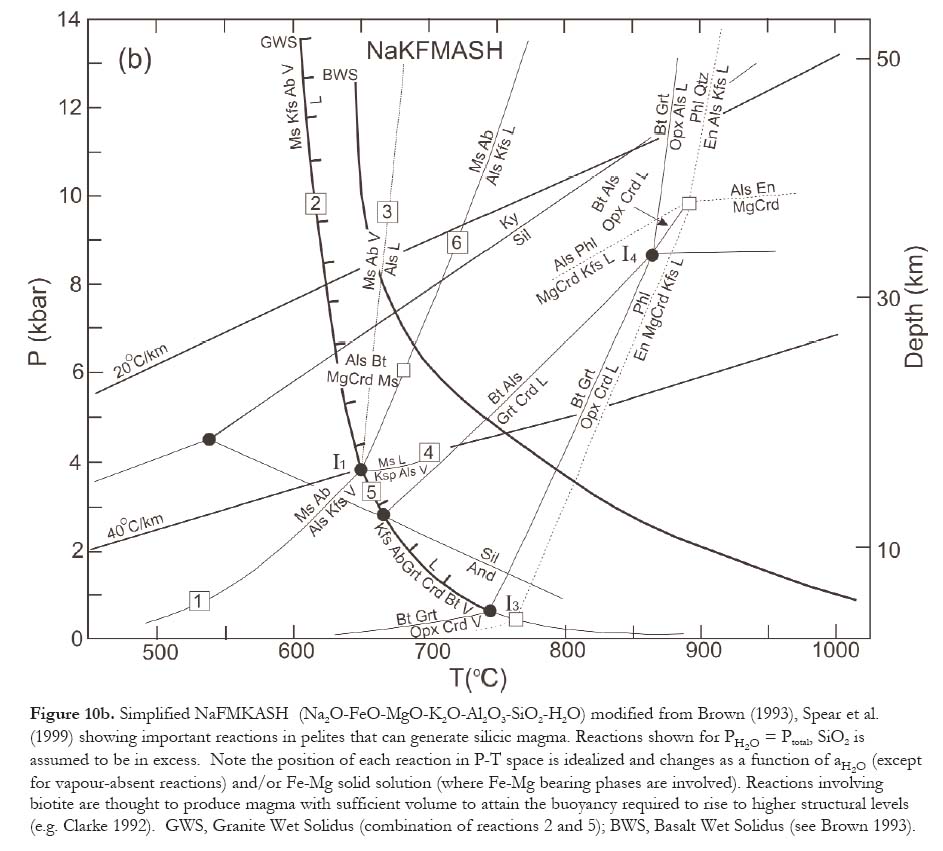
Display large image of Figure 11
55 In summary, water derived from the subducted slab plays a crucial role in all stages of arc development, starting with magma generation, then during its ascent, and finally during its cooling history. It also influences the stability of minerals in the source rock, thereby affecting bulk partition coefficients and magma chemistry. Water imparts chemical, mineralogical and textural characteristics at all stages of magma evolution.
RELATIONSHIP BETWEEN MAGMATISM, METAMORPHISM AND DEFORMATION IN ARCS
56 Over the last 30 years, it has become clear that maximum pressures and temperatures are acquired at different times during the progressive evolution of orogenic belts (e.g. Houseman et al. 1981; Brown 1993). This conclusion has profound implications for the genesis of arc magmas and their relationship to metamorphism and deformation of crustal rocks. Through a combination of thermodynamic modelling, laboratory experiments and isotopic and fission track dating, changes in pressure and temperature during the temporal evolution of orogenic belts can be documented (Pressure-Temperature-time paths, or P-T-t). Some arcs have clockwise, others have counterclockwise P-T-t paths.
Figure 11. Schematic representation of a Mohr stress analysis (the relationship between U normal and U shear, normal and shear stresses) showing the role of fluid pressure in creating fractures in the lithosphere. The maximum principal stress is given by U 1, the minimum principal stress by U 3. Dry conditions, (thin line D), hydrated conditions, thick line H). In a deviatoric stress field (given by U 1 - U 3, the diameter of the circle) increasing pH2O ( T ) reduces the effective principal stresses by T, shifting the Mohr Circle to the left and ultimately creating fractures when the Mohr Circle intersects the Mohr (fracture) envelope. When this occurs, fluid may be lost from the system, and the circle shifts temporarily to the right, until fluid builds up and repeats the process (Sibson 1987).
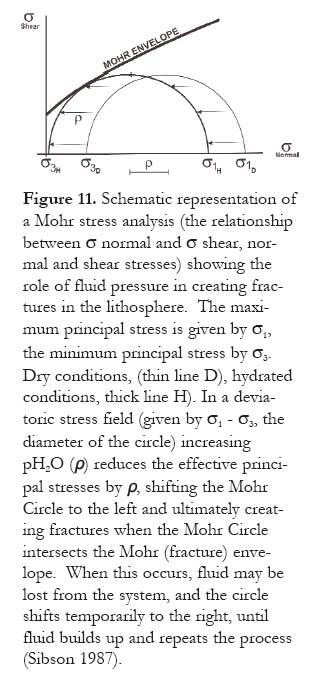
Display large image of Figure 12
57 Clockwise (CW) P-T-t paths are generated by crustal thickening followed by erosional or tectonic exhumation. Because thrusting is viewed to be geologically instantaneous, maximum P is reached in the crust before maximum T and so magma generation typically post-dates thrust-related deformation, thereby initiating a CW path. In compressional zones in arc systems, the thermal regime that gives rise to arc magmas is greatly affected by thrust and reverse faults, particularly in zones with rheologies that have been weakened by rising isotherms. The thermal effects of crustal thickening due to thrusting have been modelled (Figs. 12, 13) by England and Thompson (1986) and Thompson and Connelly (1995). For a thrust sheet 35 km thick, the net effect is to put the lower half of the thickened crust under conditions of melting. Initial magma generation takes place at the base of the crust and migrates upwards with time (Fig. 13) as successively higher structural levels cross the minimum melting curve. Note that the paths for initial post-thrusting depths of about 50 km cross the minimum melting curve about 15 million years after thrusting. Should extensional exhumation accompany thrusting, the time interval between thickening and magmatism would be reduced in duration. The above model provides insights into the spatial and temporal association of magmatism, metamorphism and deformation exhibited in many arc regimes.
58 Counter-clockwise (CCW) PT-t paths are generated when heating (and magmatism) precedes crustal thickening. Such paths can be initiated by underplating of the crust by mafic magma, possibly during a local or regional extensional event (Fig. 14). Underplating probably occurs because of viscosity contrasts at the crust-mantle boundary. As its ascent is arrested, the mafic magma spreads out laterally and heat is transferred to the base of the crust as the magma cools. If weaknesses in the crust are exploited, mafic magmas may rise to relatively shallow levels. In both situations, significant heat is transferred from the cooling mafic magma into the crust and may be enough to cause crustal melting. These tendencies may be amplified, if at the same time, the crust is undergoing extension, such as in back arc regions. The resulting crustal thinning and pressure reduction leads to a steepening of isotherms and induces partial melting in the mantle and crust. This thermal phase is followed by crustal thickening which may be coeval with mantle thinning (e.g. Sandiford and Powell 1991; Brown 1993). According to Collins (2002), however, as most granulite terranes record higher geothermal gradients (25-50°C km-1) than those reported in simple crustal thickening models (Fig. 13), voluminous magmatism and high-grade meta-morphism may preferentially occur during episodes of extension in the arc during slab roll-back. However, the inevitable arrival of microcontinents and/or oceanic plateaux at the trench may induce temporary compression, in which the rheologically softened crust undergoes thickening driving the P-T-t path to higher pressures (into a CCW path). In this scenario, crustal melts become deformed as they cool below near-solidus temperatures in a deviatoric stress field (e.g. Hibbard and Watters 1985).
CONCLUSIONS
59 There are two types of volcanic arcs – intraoceanic island arcs that may be underlain by either oceanic or continental crust, and continental arcs that form along the edge of a continent and are underlain by continental crust. Island arcs underlain by oceanic crust are dominated by mafic magmas, whereas continental arcs and island arcs underlain by continental crust are dominated by intermediate to felsic magmas. Arc magmatism is closely related to metamorphism, which may follow either clockwise or counterclockwise P-T-t paths. Clockwise P-T-t paths are initiated by crustal thickening, associated with thrusting, followed by a temperature increase due to the thermal effects of thickening. Magma forms first at the base of the crust but over tens of millions of years forms at successively higher crustal levels. Counter-clockwise P-T-t paths are initiated when heating (e.g. underplating of the crust by mafic magma) precedes crustal thickening. Clockwise P-T-t paths occur when arcs are under compression and counter-clockwise paths occur when an arc is under extension. Both conditions can occur during the lifespan of a given arc.
Figure 12. The effect of crustal thickening and thinning on the geothermal gradient (after England and Thompson 1986; see also Thompson and Connolly 1995). Thickening is assumed to have taken place instantaneously by a single thrust sheet 35 km thick (top right) and thinned to its original thickness by erosion over 100 million years (bottom left, Model A) or by extension (bottom right, Model B). For erosional and extensional models, the initial geotherm is represented by the dashed line, the final geotherm by the solid line.
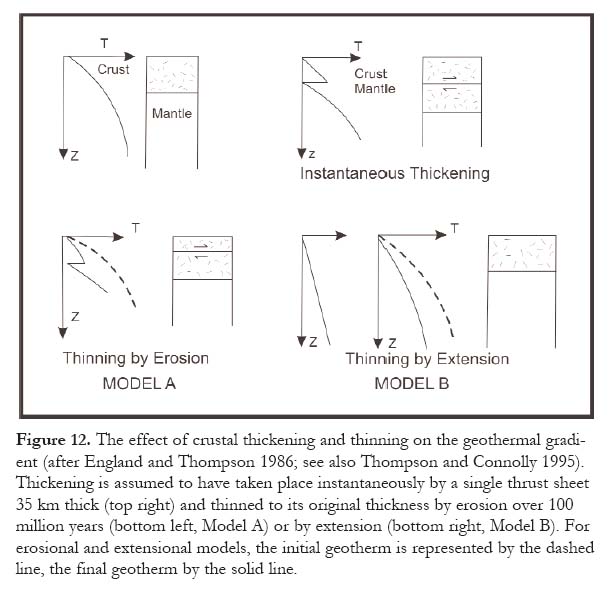
Display large image of Figure 13
60 Arc volcanism occurs in a belt about 10 km wide, which is approximately 110 km above the subduction zone. However, subduction zones can last for hundred of millions of years and changes in the location and dip of the subduction zone during that time result in arcs that are typically 200-300 km wide. The width of the fore-arc region i.e. between the arc and the trench, also changes with the dip of the subduction zone. Fore-arc crust and overlying sediments may become imbricated and transferred to the subducting slab, a process known as subduction erosion.
61 The backarc region, another important site of magmatism, is characterized by high heat flow, and undergoes repeated episodes of extension and compression. During the extensional phase, basins develop that are filled with sediments and a steepened geothermal gradient produces extensive magmatism in the rheologically weakened and thinned crust. During a prolonged history of subduction, the basin fill provides a fertile chemistry for the generation of magmas during subsequent phases of compression or extension.
62 Water plays a fundamental role at all stages of magma evolution. Water lowers the solidus temperatures in the mantle and crust because it weakens mineral structures. In addition, rising water acts as a heat flux. The composition of the fluid at the site of melting has a major influence on the composition of the magmas produced. This fluid probably has components of the invading fluid from the subduction zone, the indigenous fluid previously added to the mantle wedge, and the fluid released by mantle minerals. Thus, reaction between the invading fluid, mantle minerals and previously added fluid may influence the mineral composition of the mantle, as well as change the composition of the fluid. The composition of the fluid at the time of melting influences the chemistry of the magma produced, and therefore, the composition of the resulting arc rocks.
63 Water also plays an important role in the ascent and cooling of magma. High pore-water pressure can induce fracturing in the crust subjected to deviatoric stress, which allows magma and fluids to rise more rapidly. Water depolymerises melt structure, and the resulting decrease in viscosity allows minerals to grow more rapidly. Arc lavas, especially those of intermediate composition, are characterized by plagioclase phenocrysts with oscillatory zoning that records variations in temperature, composition and water content of the melt during magma crystallization.
64 As volatiles partition into magma, source rocks may become dehydrated so that aH2O < 1, which causes melt-generating reactions to migrate to higher temperatures, and thus, inhibits the formation of significant quantities of magma. If, however, water is continually replenished, directly or indirectly, by ongoing dehydration of the subducting slab, then magma generation can proceed under water-saturated conditions at lower temperatures. Several mechanisms may combine to facilitate the rise of arc magmas towards the surface. Large plutons appear to represent the end result of multiple intrusions. Buoyant magma has the tendency to form teardrop-shaped diapirs, particularly in the duc-tile lower crust. Many diapirs appear to have exploited zones of structural weakness in the crust, where rapid ascent resulted in expansion and further fracture propagation in the roof above the magma chamber, facilitating further rise by stoping and assimilation. The presence of water in magmas also aids in fracture propagation. Volatile overpressure and extensional tectonic regimes in the arc (e.g. local pull-apart structures) permit rapid rise of magma. Significant volumes of magma migrate through a variety of structural weaknesses and the net result may be a composite batholith that is typical of arc systems.
Figure 13. Geotherms and pressure-temperature-time (P-T-t) model paths for model A of Figure 12 (modified after England and Thompson 1986). Thickening due to thrusting is assumed to be geologically instantaneous. GWS (granite wet solidus, PH2O = Ptotal) is the curve for melting of crustal rocks. The lower diagram shows P-T-t paths over 100 million years in 10 Ma increments (filled circles, every 20 million years labelled) during which time the thrust sheet was completely eroded and the crust was returned to its original thickness. The field of granulites occurs at higher T than GWS, and the P-T derived from their minerals are consistent with geothermal gradients between 20°C and 50°C per km (from Harley 1989; Collins 2002). Barrovian metamorphism (open arrows) is from Jamieson et al. (1998). Hypothetical P-T-t path for crust at 60 km depth immediately after thrusting (black arrows). This path crosses the minimum melting curve within 10 million years of the time of thickening.Figure 14. Rising basaltic magma underplates the continental crust, and the heat content of this magma is sufficient to partially melt the overlying continental crust (after Hildreth 1981). This process may occur during the extensional phase in the development of the arc and may initiate a CCW path.ACKNOWLEDGEMENTS
Much of what I have learned about arc magmatism has been through collaboration and conversations with colleagues including Alan Anderson, Randy Cormier, Richard D’Lemos, Jarda Dostal, Andrew Hynes, Duncan Keppie, Damian Nance, Georgia Pe-Piper, Cecilio Quesada, Rob Strachan and participants in various UNESCO-IGCP projects. I am grateful to NSERC Canada for research funding, for which arc systems are a major part, to Randy Cormier for reading an early draft, to Randy, Derek Thorkelson and Steve Johnston for thorough, constructive reviews, Georgia Pe-Piper, Steve McCutcheon and Sonya Dehler for editorial advice, and to Matt Middleton (funded by NSERC Research Capacities Development grant) for cheerful technical assistance.REFERENCES
Allen, C.M., 1992, A nested diapir model for the reversely zoned Turtle Pluton, southeastern California: Transactions of the Royal Society of Edinburgh, Earth Sciences, v. 83, p. 179-190.
Arculus, R.J., and Curran, E.B., 1972, The genesis of the calc-alkaline rock suite: Earth and Planetary Science Letters, v. 15, p. 255-262.
Baluyev, E.Y., and Perepelov, A.B., 1988, Mineralogical and geochemical features of high-potash andesites in the frontal part of the Kamchatka island arc: Geokhimiya, v. 6, p. 813-824.
Bird, P., 1988, Formation of the Rocky Mountains, western United States: a continuum computer model: Science, v. 239, p. 1601-1507. Blatt, H., Tracy, R.J., and Owens, B., 2005, Petrology, Igneous, Sedimentary, Metamorphic, 3rd Edition: W.H. Freeman Publishers, 529 p.
Boettcher, A.L., 1977, The role of amphibole and water in circum-Pacific volcanism, in Manghnani, M.H. and Akimoto, S., eds., High Pressure Research Applications in Geophysics: Academic Press, London, pp. 107-126.
Bowen, N.L., 1928, Evolution of the Igneous Rocks: Princeton University Press, 332p.
Bowring, S.A., and Williams, I.A., 1999, Priscoan (4.00-4.03 Ga) Orthogneisses from Northwestern Canada: Contributions to Mineral-ogy and Petrology, v. 134, p. 3-16.
Brown, M., 1993, P-T-t evolution of orogenic belts: Journal of the Geological Society, London, v. 150, p. 227-241,
Brown, M., and Solar, G.S., 1998, Shear-zone systems and melts: feedback relations and self-organization in orogenic belts: Journal of Structural Geology v. 20, p. 211-227.
Cashman, K.V., Sturtevant, B., Papale, P., and Navon, O., 2000, Magmatic fragmentation, in Sigurdsson, H., Houghton, B.F., McNutt, S.R., Rymer, H., and Stix, J., eds., Encyclopedia of Volcanoes: Academic Press, p. 421-430.
Chapman, D.S., and Furlong, K.P., 1992, Thermal state of the continental crust, in Fountain, D.M., Arculus, R.J., and Kay, R.W., eds., Continental Lower Crust: Developments in Geotectonics 23: Elsevier, Amsterdam, p. 179-199.
Clarke, D.B., 1992. Granitoid Rocks: Chapman Hall, London, 283 pp.
Clarke, D.B., Henry, A.S., and White, M.A., 1998, Exploding xenoliths and the absence of "elephant’s graveyards" in granite batholiths: Journal of Structural Geology, v. 20, p. 1325-1343.
Clemens, J.D., 1998, Observations on the origins and ascent mechanisms of granitic magmas: Journal of the Geological Society, London, v. 155, p. 843-851.
Cole, J.W., Brown, S.J.A., Burt, R.M., Beresford S.W., and Wilson, C.J.N., 1998, Lithic types in ignimbrites as a guide to the evolution of a caldera complex, Taupo volcanic centre, New Zealand: Journal of Volcanology and Geo-thermal Research, v. 80, p. 217-237.
Cole, J.W., Milner, D.M. and Spinks, K.D., 2005, Calderas and caldera structures: A Review: Earth Science Reviews, v. 69, p. 1-26.
Coleman, D.S., Gray, W., and Glazner, A.F., 2004, Rethinking the emplacement and evolution of zoned plutons: Geochronologic evidence for incremental assembly of the Tuolumne Intrusive Suite, California: Geology, v. 32, no. 5, p. 433-436.
Collins, W.J., 2002, Hot orogens, tec-tonic switching and creation of continental crust: Geology, v. 31, p. 535-538.
De Silva, S.L., 1989, Altiplano–Puna volcanic complex of the central Andes: Geology, v. 17, p. 1102-1106.
Dewey, J.F., 1980, Episodicity, sequence and style at convergent plate margins: Geological Association of Canada Special Paper 20, p. 553-574.
Dickinson, W.R., and Snyder, W.S., 1979, Geometry of subducted slabs related to the San Andreas transform: Journal of Geology, v. 87, p. 609-627.
Dixon, J.M., and Farrar, E., 1980. Ridge subduction, eduction, and the Neogene tectonics of southwestern North America: Tectono-physics, v. 67, p. 81-99.
Downey, W.S., and Lentz, D.R., 2006, Modelling of deep submarine pyroclastic volcanism: A review and new results: Geoscience Canada, v. 33, p. 5-24.
Eggler, D.C., 1978, The effect of CO2 on the partial melting of peridote in the system Na2O-CaO-Al2O3-MgO-SiO2-CO2 to 35 kb, with analysis of melting in a peridotite-H2O-CO2 system: American Journal of Science, v. 278, p. 305-343.
England, P.C., and Thompson, A.B., 1986, Some thermal and tectonic models for crustal melting in continental collisional zones: in Coward, M.P., and Ries, A.C., eds., Collisional Tectonics: Geological Society of London Special Publication 19, p. 83-94.
English, J., Johnston, S.T., and Wang, K., 2003, Thermal modeling of the Laramide orogeny: Testing the flat slab subduction hypothesis: Earth and Planetary Science Letters, v. 214, p. 619-632 .
Ferrari, L., Pasquarè, G., and Tibaldi, A., 1989, Volcanic and tectonic evolution of Los Azufres caldera and surrounding area, Mexico: Annales Geophis. Spec. Iss. EGS XIV Gen. Assembly, Barcelona, 57p.
Fitch, T.J., 1972, Plate convergence, transcurrent faults, and internal deformation adjacent to southeast Asia and the Western Pacific: Journal of Geophysical Research, v. 77, p. 4432-4460.
Foden, D., and Green, D.H., 1992, Possible role of amphibole in the origin of andesite: some experimental and natural evidence: Contributions to Mineralogy and Petrology, v. 109, p. 479-493.
Gill, J.B., 1981, Orogenic Andesites and Plate Tectonics: Springer Verlag, Berlin, 390 p.
Glazner, A.F., and Bartley, J.M., 2006, Is stoping a volumetrically significant pluton emplacement process? Geological Society of America Bulletin, v. 118, p. 1185-1195.
Guineberteau, B., Vigneresse, J.-L., and Bouchez, J.-L., 1987, The Mortagne granite pluton (France) emplaced by pull-apart along a shear zone: Structural and gravi-metric arguments and regional implication: Geological Society of America Bulletin, v. 99, p. 763-770.
Gutscher, M.-A., 2002, Andean subduction styles and their effect on thermal structure and interplate coupling: Journal of South American Earth Sciences, v. 15, p. 3-10.
Gutscher, M-A., Spakman, W., Bijwaard, H., and Engdahl, E.R., 2000, Geodynamics of flat subduction: Seismicity and tomographic constraints from the Andean margin: Tectonics, v. 19, p. 814-833.
Harley, S.L., 1989, The origins of granulites: A metamorphic perspective: Geology Magazine, v. 126, 215-247.
Hibbard, M.J., and Watters, R.J., 1985, Fracturing and dyking in incompletely crystallized granitic plutons: Lithos, v. 18, p. 1-12.
Hildreth, W., 1981, Gradients in silicic magma chambers, implications for lithospheric magmatism: Journal of Geophysical Research, v. 86, p. 10153-10192.
Hoorn, C., Guerrero, J., Sarmiento, G.A., and Lorente, M.A., 1995, Andean tectonics as a cause for changing drainage patterns in Miocene northern South America: Geology v. 23, p. 237-240.
Houseman, G.A., MacKenzie, D.P., and Molnar, P., 1981, Convective instability of a thickened boundary layer and its relevance for the thermal evolution of convergent continental belts: Journal of Geophysical Research, v. 86, p. 6115-6132.
Hutton, D.H.W., 1988, Transactions of the Royal Society of Edinburgh: Earth Sciences: v. 79, p. 245-255.
Hutton, D.H.W., 1992, Granite sheeted complexes: Evidence for the dyking ascent mechanism: Transactions of the Royal Society of Edinburgh, Earth Sciences, v. 83, p. 377-382.
Hyndman, R.D., Currie, C.A., and Mazzotti, S.P., 2005, Subduction zone backarcs, mobile belts, and orogenic heat: GSA Today, v. 15, no. 2, p. 4-10.
Hynes, A.J., and Mott, J., 1985, On the causes of back-arc spreading: Geology, v. 13, p. 387-389.
Jamieson, R.A., Beaumont, C., Full-sack, P., and Lee, B., 1998, Barrovian regional metamorphism: Where’s the heat, in Treloar, P.J., and O’Brien, P.J., eds., What Drives Metamorphism and Metamorphic Reactions: Geological Society of London Special Publication 138, p. 23-51.
Johnson, S.E., Albertz, M., and Paterson, S.R., 2001, Growth rates of dike-fed plutons: are they compatible with observations in the middle and upper crust?: Geology, v. 21, p. 727-730.
Kay, S.M., Kay, R.W., and Citron, G.P., 1982, Tectonic controls on tholeiitic and calc-alkalic magmatism in the Aleutian arc: Journal of Geophysical Research, v. 87, p. 4051-4072.
Kelemen, P.B., 2004, One view of the geochemistry of subduction-related magmatic arcs, with an emphasis on primitive andesite and lower crust, in, Holland H.D.and Turekian K.K., eds.,Treatise on Geochemistry: Elsevier-Pergamon, Oxford, p. 593-659.
Koukouvelas, I., Pe-Piper, G., and Piper, D.J.W., 2002, The role of dextral transpressional faulting in the evolution of the early Carboniferous mafic-felsic plutonic and volcanic complex: Cobequid Highlands, Nova Scotia, Canada: Tectonophysics, v. 348, p. 219-246.
Leibscher, A., 2004, Decoupling of fluid and trace element release in subducting slab? Comment on "Redistribution of trace elements during prograde metamorphism from lawsonite blueschist to eclogite facies; implications for deep subduction-zone processes" by C. Spandler et al. (Contrib. Mineral Petrol. 146:205-222, 2003): Contributions to Mineralogy and Petrology, v. 148, p. 502-505.
Marsh, B.D., 1979, Island arc development: some observations, experiments and speculations: Journal of Geology, v. 87, p. 687-713.
Marsh, B.D., 1982, On the mechanisms of igneous diapirism, stoping and zone melting: American Journal of Science, v. 282, p. 808-855.
Marsh, B.D., 1988, Magma Chambers: Annual Review of Earth and Planetary Sciences, v. 17, p. 439-474.
Martin, H., 1987, Petrogenesis of Archean Trondheimites, tonalites and granodiorites from eastern Finland: Journal of Petrology, v. 28, p. 921-953.
Miller, R.B., and Paterson, 1999, In defence of magmatic diapirs: Journal of Structural Geology, v. 16, p. 853-865.
Miller, R.B., and Paterson, S.R., 2001, Construction of mid-crustal sheeted plutons: Examples from the north Cascades, Washington: Geological Society of America Bulletin, v. 113, p. 1423-1442.
Miyashiro, A., 1974, Volcanic rock series in island arcs and active continental margins: American Journal of Science, v. 274, p. 321-355.
Molnar, P., and Atwater, T., 1978, Interarc spreading and Cordilleran tectonics as alternates to the age of the subducted oceanic lithosphere: Earth and Planetary Science Letters, v. 41, p. 330-340.
Morris, J.D., and Ryan, J.G, 2004, Subduction zone processes and implications for changing composition of the upper and lower mantle, in, Holland, H.D. and Turekian, K.K., eds.,Treatise on Geochemistry: Elsevier-Pergamon, Oxford, p. 451-470.
Murphy, J. B. 1989, Tectonic characteristics and metamorphism of mineralized shear zones, in, Bursnall, J.T., ed., Mineralization and Shear Zones, Geological Association of Canada, Short Course Notes, v. 6, p. 20-49.
Murphy, J.B., 2007, Arc magmatism II: Geochemical and isotopic constraints on petrogenesis. Geo-science Canada, v. 34, in press.
Murphy, J. B., and Hynes, A. J., 1990, Tectonic control on the origin and orientation of igneous layering: an example from the Greendale Complex, Nova Scotia: Geology, v.18, p. 403-406.
Murphy, J.B., Oppliger, G., Brimhall, G.H., Jr., and Hynes, A.J., 1998, Plume-modified orogeny: an example from the southwestern United States: Geology, v. 26, p. 731-734.
Mysen, B.O., 1988, Structure and Properties of Silicate Melts: Elsevier, Amsterdam, 368 p
Mysen, B.O. and Boettcher, A.L., 1975, Melting of a hydrous mantle. I. Phase relations of natural peridotite at high pressures and temperatures with controlled activities of water, carbon dioxide and hydrogen: Journal of Petrology, v. 33, p. 347-375.
Paterson, S.R., and Tobsich, O.T., 1992, Rates of processes in magmatic arcs: implications for the timing and nature of pluton emplacement and wall rock deformation: Journal of Structural Geology, v. 14, p. 291-300.
Paterson, S.R., and Vernon, R.H., 1995, Bursting the bubble of ballooning plutons: A return to nested diapirs emplaced by multiple processes: Geological Society of America Bulletin, v. 107, p. 1356-1380.
Paterson, S.R., Vernon, R.H., and Fowler, T.K., 1991, Aureole tec-tonics: in, Kerrick, D.M., ed., Contact Metamorphism: Reviews in Mineralogy, v. 26, p. 105-126.
Peacock, S.M., Rushmer, T., and Thompson, A.B., 1994, Partial melting of subducting oceanic crust: Earth and Planetary Science Letters, v. 121, p. 227-244.
Petford, N., Cruden, A.R., McCaffrey, K.J.W., and Vigneresse, J.L., 2000, Granite magma formation, transport and emplacement in the Earth’s crust: Nature, v. 408, p. 669-673.
Pilger, R.H., 1981, Plate reconstruction, aseismic ridges, and low angle subduction beneath the Andes: Geological Society of America, Bulletin, v. 92, p. 448-456.
Pitcher, W.S., 1993, The Nature and Origin of Granite: Blackie, London, p. 321.
Ramos, V.A., and Aleman, A., 2000, Tectonic evolution of the Andes, in Cordani, U.G., Thomaz Filho, A., and Campos, D.A., eds., Tec-tonic Evolution of South America: p. 635-688. 31st International Geological Congress, Rio de Janeiro, Brasil.
Ramos, V.A., Cristallini, E.O., and Pérez, D.J., 2002, The Pampean flat-slab of the Central Andes: Journal of South American Earth Sciences, v. 15, p. 59-78.
Ringwood, A.E., 1977, Petrogenesis in island arc systems: in Talwani, M.,and Pitman, W.C. eds., Island Arcs, Deep Sea Trenches, and Back-Arc Basins. Maurice Ewing Series #1, American Geophysical Union, Washington D.C., p. 311-324.
Sandiford, M., and Powell, R., 1991, Some remarks on high-temperature–low-pressure metamorphism in convergent orogens: Journal of Metamorphic Geology, v. 9, p. 333-340.
Sato, H., 1994, The relationship between late Cenozoic tectonic events and stress field and basin development in northeast Japan: Journal of Geophysical Research, v. 99, p. 22261-22274.
Sawyer E.W., 1994, Melt segregation in the continental crust: Geology, v. 22, p. 1019-1022.
Schreyer, W., 1988, Subduction of continental crust to mantle depths: Episodes, v. 11, p. 97-104.
Shelley, D., 1993, Igneous and Meta-morphic Rocks under the Microscope: Chapman and Hall, London.
Sibson, R.H., 1987, Earthquake rupturing as a mineralizing agent in hydrothermal systems: Geology, v. 15, p. 701-704.
Spandler C., Hermann J., Arculus R., and Mavrognes J., 2003, Redistribution of trace elements during pro-grade metamorphism from lawsonite blueschist to eclogite facies; implications for deep subduction-zone processes: Contributions to Mineralogy and Petrology, v. 146, p. 205-222.
Sparks, R.S.J., Self, S., and Walker, G.P.L., 1973, Products of ignimbrite eruptions: Geology, v. 1, p. 115-118.
Spear, F.S., Kohn, M.J., and Cheney, J.T., 1999, P-T paths from anatectic melts: Contributions to Miner-alogy and Petrology, v. 134, p. 17-32.
Spinks K.D., Acocella, V., Cole, J.W., and Bassett, K.N., 2005, Structural control of volcanism and caldera development in the transtensional Taupo Volcanic Zone, New Zealand: Journal of Volcanology and Geothermal Research, v. 144, p. 7-22.
Stern, C.R. 1991, The role of subduction erosion in the generation of Andean magmas: Geology, v. 19, p. 78-91.
Stern, R.J., 2002, Subduction Zones: Reviews of Geophysics, 10.1029/2001RG0001
Stewart, M., and Fowler, A.D., 2001, The nature and occurrence of discrete zoning in plagioclase from recently erupted andesitic volcanic rocks, Montserrat: Journal of Volcanology and Geothermal Research, v. 106, p. 243-253.
Tatsumi, Y., and Eggins, S., 1995, Subduction Zone Magmatism: Boston, Blackwell Science, 211p.
Thompson, A.B., 1983, Fluid absent metamorphism: Journal of the Geological Society, London, v. 140, p. 533-547.
Thompson, A.B., and Algor, J.R., 1977, Model systems for anatexis of pelitic rocks I: Theory of melting reactions in the system KAlO2-NaAlO2- Al2O3- SiO2- H2O: Contibutions to Mineralogy and Petrology, v. 63, p. 247-269.
Thompson, A.B., and Connolly, J., 1995, Melting of the continental crust: Some thermal and petrological constraints on anatexis in continental collisional zones and other tectonic settings: Journal of Geophysical Research, v. 100, p. 15565-15579.
Tibaldi, A., 1992, The role of transcur-rent intra-arc tectonics in the configuration of a volcanic arc: Terra Nova, v. 4, p. 567-577.
Tibaldi, A., and Ferrari, L., 1990, A wedge model for the Quaternary tectonics of the Andes of Ecuador: Proc. Symp. Int. Geodyn. Andine, ORSTOM, Grenoble, p. 119-121.
Uyeda, S., 1978. A New View of the Earth: W.H. Freeman and Company, San Francisco.
Vigneresse, J.L., and Bouchez, J.L., 1997, Successive granitic magma batches during pluton emplacement: The case study of Cabeza de Araya, Spain: Journal of Petrology, v. 38, p. 1767-1776.
Wiens, D.A., and Smith, G.P., 2003, Seismological constraints on structure and flow patterns within the mantle wedge, in Eiler, J., ed., Inside the Subduction Factory: American Geophysical Union, Geophysical Monograph 138, p. 59-81.
Winter, J.D., 2001, An Introduction to Igneous and Metamorphic Petrology: Prentice Hall, New Jersey, 695p.
Xu, S., Okay, A.I, Sengor, A.M.C., Su, W., Liu, Y., and Jiang, L., 1992, Diamond from the Dabic Shan metamorphic rocks and its implication for tectonic setting: Science, v. 256, p. 80-82.
Yáñez, G., Ranero, G.R., von Huene, R., and Díaz, J., 2001, Magnetic anomaly interpretation across a segment of the Southern Central Andes (32-34°S): implications on the role of the Juan Fernández Ridge in the tectonic evolution of the margin during the upper Tertiary: Journal of Geophysical Research, v. 106, p. 6325-6345.
Yardley, B.D., 1989, An Introduction to Metamorphic Petrology: Long-man Earth Sciences, Harlow, 248p.
Yoder, H.S., and Tilley, C.E., 1962, The origin of basaltic magmas: an experimental study of natural and synthetic rock systems: Journal of Petrology, v. 3, p. 342-532.
Zák, J., and Paterson, S.R., 2005, Characteristics of internal contacts in the Tuolumne Batholith, central Sierra Nevada, California (USA): implications for episodic emplacement and physical processes in a continental arc magma chamber: Geological Society of America Bulletin, v. 117, p. 1242-1255.
